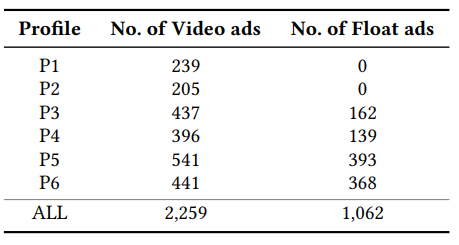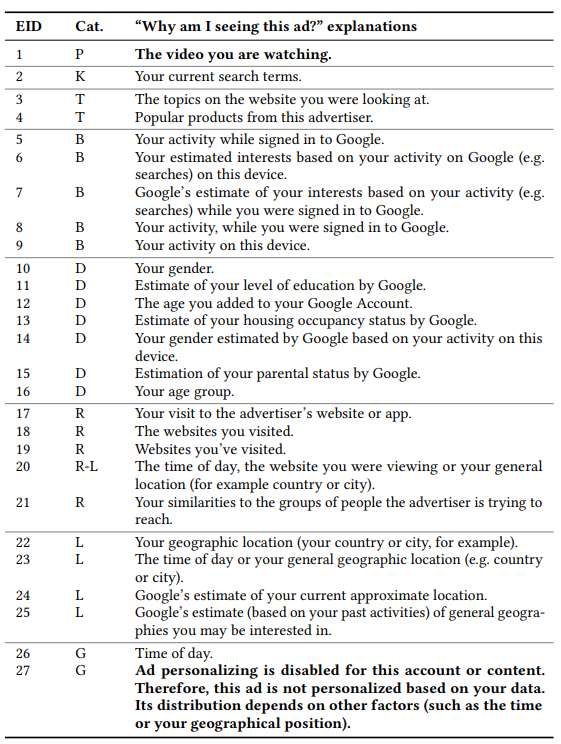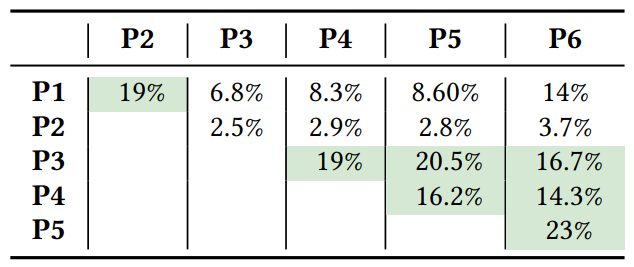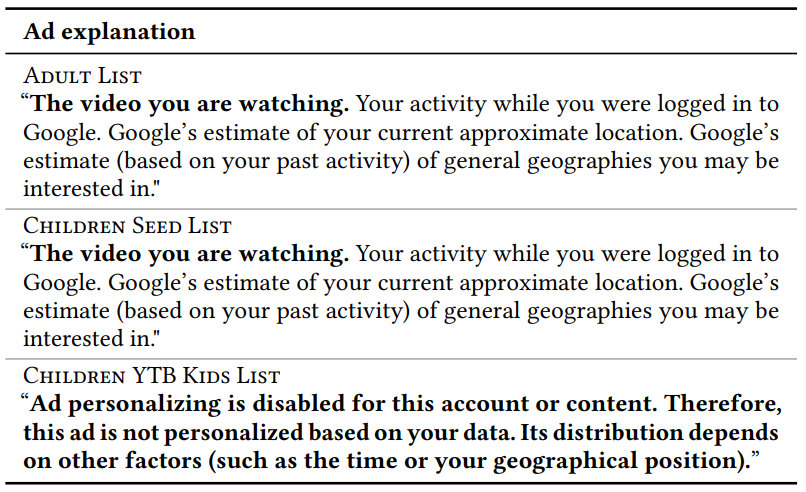Authors:
(1) Tinhinane Medjkoune, Univ. Grenoble Alpes, CNRS, Grenoble INP, LIG France;
(2) Oana Goga, LIX, CNRS, Inria, Ecole Polytechnique, Institut Polytechnique de Paris France;
(3) Juliette Senechal, Université de Lille, CRDP, DReDIS-IRJS France.
Table of Links
Legislation on Advertising to Children
Mechanisms for Targeting Children
Usage of Placement-Based Targeting
Conclusion, Acknowledgements and References
5 USAGE OF PLACEMENT-BASED TARGETING
This section proposes a measurement methodology to investigate whether advertisers, in the wild, are exploiting placement-based targeting to advertise their products to children.
5.1 Data collection methodology
Our methodology is based on a browser extension that can capture information about the ads shown when a user is watching a YouTube video. At a high level, the measurement methodology consists in instructing six browser profiles to watch children-focused videos and collect the ads shown.
Ad capture tool. Each time an ad is shown to the user, the DOM is updated to add new elements to the HTML code of the video watched. So, to capture ads, our browser extension simply monitors the DOM for changes. Our extension works on Chrome and can capture both video ads–video ads launched at the beginning, middle, or end of a watched video; and float card ads–ads containing an image, a GIF, or text showed while watching a video above the navigation bar. When our browser extension detects an ad, it collects the following information (mainly textual):
• Ad data: The name of the advertiser, the advertiser’s YouTube channel, the advertiser’s link, the image or GIF in the case of float ads, and the URL of the ad for video ads.
• Video watched data: We collect the title of the video watched (the video on which the ad appears), its URL, its description, the nb. of views, the date the video was published, the corresponding channel, and the nb. of channel followers.
• YouTube Kids redirection: We collect if YouTube proposes redirecting the user to YouTube Kids (it means the video is on YouTube Kids–see Figure 2 in appendix).
• Ad explanation: The browser extension collects data that appears in the “Why am I seeing this ad?” feature. This feature can be accessed by clicking on the button ○i at the bottom left of the ad video. A modal opens and describes to users the reasons the ad was shown to them. We collect this information by simulating a click on the button, and thus we recover the response to the request sent after the click. To close the modal, we simulate another click outside the modal’s window.

We do not collect information about the profile/identity watching the video (each user is associated with a unique identifier generated by the browser extension). This data is sent and stored in our lab servers through a secure HTTPS connection. The storage server is protected by a firewall.
Personas. The ads shown when someone watches a video on YouTube can depend on the browser profile (as determined by the cookies present in the browser that track sites previously visited) and the Google profile of the user in case the user is logged in. Hence, to have a broader view and account for how the browser profile could influence the results, we created six browsing profiles with different parameters–see Table 2.
We created: (1) Two browser profiles without a Google profile associated and no browsing history. (2) Two profiles are associated with an empty Google profile with no gender specification and no browsing history (the profiles only have the age set because the users are obliged to specify the date of birth to create a Google account). And (3) two profiles are associated with Google accounts and browsing history. One account has the gender set to female and the other to male. For the female profile, we visited four sites related to clothes, cats’ food, Volkswagen cars, and animal rights in France; for the male profile, we visited one site related to plastic surgery. For P3-P6, we checked the Google Ads Settings page to investigate what interests Google has inferred for the different profiles [34]. P3 and P4 have, as expected, no interests. The P5 profile had Fashion & Trend, Pets, and Auto & Vehicles as interests, and P6 had Body Care & Fitness as interests. These interests are consistent with the sites consulted.
Google does not allow children (younger than 18 years old) to create Google profiles. Our profile choice is motivated by the possibilities offered by Google for how a child could watch videos on YouTube: (1) a child can use an incognito browser that is not connected to any profile; (2) a child could create an account with an erroneous age; or (3) a child can use the account of one of his/her parents, who may have already used this account on sites and applications so that browsing history is already present.
Instrumentation. We conducted our data collection on YouTube between April 28th 2022 and May 5th 2022. We collected data simultaneously from the six profiles on two different computers. We launch the six personas simultaneously by creating six Selenium sessions. The personas browse the ten most recent videos in each of the channels in the three lists: Children YTB Kids List, Children Seed List, and Adult List. Each video was watched from start to finish. With the help of the extension, each ad served is collected and stored on our servers. Our stopping point is the end of the entire YouTube channel list–620 videos. Table 3 shows the number of video and float card ads we collected for each list and each profile. Across the six profiles, we collected 3,221 ads.

Note on experimental difficulties: The data collection is time-consuming: (1) we need to watch videos until the end to catch all ads because ads can appear at random times during the video, and there is no fixed number of ads that appears during a video. The length of the videos varies from less than 2 minutes to more than one hour. And (2) our simulated double-click to recover the information in the “Why am I seeing this ad?” sometimes triggers a modal that does not close, interrupting the video’s progress and therefore requiring human intervention to close the modal and restart the video. This limits the scale of the experiment. Nevertheless, since this paper focuses on whether advertisers use placement-based advertising to target children and not on providing a representative characterization of ads shown on children-focused videos, we believe that our instrumentation with six browser profiles is enough.
5.2 Detection of placement-based targeting
The reasons why an ad is shown on a video depend on the targeting parameters set by the advertiser and the platforms’ algorithms to deliver ads. In this paper, we focus on placement-based advertising. Hence, given a set of ads shown on a video, the challenge is to distinguish between ads targeted at the video (i.e., placement-based) and ads that were shown due to other reasons (e.g., interest-based, re-targeting).
Our first idea was to watch the same video simultaneously, using multiple browser profiles, and consider only ads present in all profiles as placement-based ads. Out of the 668 unique ads we collected across the six profiles, only two ads were received by all six profiles. For information, 39 ads were received by four or more profiles, and 128 ads were received by two or more profiles. Nevertheless, this method sadly suffers from both false positives (the ad appears in all profiles because the advertiser launched a very big campaign and it is outbidding the competition) as well as false negatives (an ad might be placement-based but does not appear in all videos because of budget constraints and competition). Therefore, this method cannot provide reliable ground truth.
Luckily, Google provides users explanations for why they received a particular ad in the “Why you’re seeing this ad” feature (see Section 2). Hence, we decided to investigate whether these explanations are precise enough to help us distinguish between placement-based ads and the rest. Our Chrome extension was able to collect the information in the “Why you’re seeing this ad” button for all the ads we collected. Table 4 shows the different explanations provided by Google. Note that our study was conducted in French, so the reasons in the table are translated from French and might have a slightly different syntax in English. We group these reasons into eight broad targeting categories: P–placement-based ads; R–Re-targeting ads; T–Theme-based ads; K–Keyword-based; I– Identity-based; B–Behavioral or interest-based; L–Location-based; and G-General targeting. The different ad explanations cover the different targeting types offered by Google, and the explanations provided are quite precise such as “The topics on the website you were looking at” or “Estimate of your housing occupancy status by Google”. More interesting for us, the explanation with EID 1, “The video you are watching” seems to correspond to placement-based advertising. Another interesting explanation is EID 27, “Ad personalizing is disabled for this account or content. Therefore, this ad is not personalized based on your data.” as it clearly states that the ad is not personalized. This is interesting because Google claims to not deliver personalized ads on children-focused videos [63, 64].
Validation. Previous works have shown that ad explanations on Facebook were incomplete and misleading [4]. While it is outside the scope of this paper to perform a full audit of ad explanations on YouTube, we validate the correspondence between placement-based targeting and the “The video you are watching? ad explanation. For this, we analyze its: (1) sensitivity – the extent to which when an advertiser uses placement-based targeting, this is the corresponding ad explanation Google provides users; and its (2) specificity – the extent to which this ad explanation does NOT appear on ads that do not use placement-based targeting. For example, if the ad explanation EID 1 also appears on ads that use theme-based targeting, then it is not specific to placement-based targeting.
We created a Google ad campaign targeting only one specific video to investigate the sensitivity. Then we instructed the six browser profiles to watch the video we targeted, collect whether our ad was shown, and collect the corresponding explanation from Google. In every instance where we collected our ad, Google provided the “The video you are watching” (EID 1) ad explanation. We repeated the experiment in three ad campaigns with other placements and always got EID 1. Hence, as expected, EID 1 is given for ads that use placement-based targeting.
The specificity is harder to demonstrate as the ad platform provides numerous targeting parameters to advertisers, and it is hard to prove that no other combination of targeting parameters results in an EID 1 explanation. The difficulty comes from a combination of technical and financial issues: it is hard using a few browser profiles to catch an ad that was, for example, targeted at users interested in “Shopping” when being on a limited ad budget, as the likelihood of our ad being seen by our profiles is very low.
Hence, we tested the specificity with respect to four types of targeting (theme-based, behavioral-based, demographic-based, and general-based), which is a subset of all possible targeting strategies, but covers some of the most used targeting techniques. For this, we again created four ad campaigns that used the four types of targeting and tried to collect our ads and check the explanation provided by Google. For none of the ad campaigns, we collected a “The video you are watching” explanation, and the ad explanations provided were coherent with our categorization in Table 4. Hence, while we cannot prove absolute specificity, we show the specificity of EID 1 with respect to these four categories of targeting.

One concern we did not manage to test is what explanation Google provides if an advertiser selects the “audience expansion” feature when using placement-based targeting. This feature allows Google to deliver the ad on videos other than the ones initially specified by the advertiser. If Google provides the EID 1 explanation for all the ads it delivers as part of this campaign, this could lead to false positives, as the EID 1 explanation will appear on videos selected by Google in addition to the videos specified by the advertiser in its placements.
Limitation: Since we cannot fully prove the specificity of “The video you are watching” ad explanation, our results should be read as an upper bound on placement-based targeting.
Note: We conducted our data collection on YouTube rather than YouTube Kids. The main technical reason behind this is that YouTube Kids does not offer users the “Why am I seeing this ad?” feature; hence, we cannot deduct when advertisers use placement-based advertising. Nevertheless, surveys claim that YouTube is still used more than YouTube Kids by parents [45]. Hence, it also makes practical sense to investigate placement-based advertising on YouTube.

5.3 Analysis of ads
This section analyzes the 3,221 ads we collected with the six profiles when watching the 620 videos in YouTube.
Ad frequency. Table 3 shows the number of video and float ads we collected with the different profiles. We can see that P1 and P2, which do not have associated Google profiles, have not received any float ads and have the lowest number of video ads. For the other profiles, we can notice that they receive approximately the same number of ads. Still, the highest number of ads are for browser profiles associated with Google profiles with browsing history (P5 and P6).
Overlap. Table 5 reports the overlap in video ads between the six browser profiles. Recall that all six browser profiles are watching the same videos at relatively the same time. To compute the overlap, we computed the unique set of video ads for each profile and computed the intersection between the different profiles. We can see that the overlap between P1 and P2 is 19% (the two browser profiles are not associated with Google profiles). In contrast, the intersection of either P1 or P2 with the rest of the profiles is much lower. The intersection between the four profiles associated with a Google profile, with or without browsing history, is between 15% to 23%. This suggests that the set of ads received by browser profiles not associated with a Google profile differs from browser profiles with an associated Google profile.
Placement-based ads. The central question of this section is whether advertisers employ placement-based targeting on children-focused videos in the real-world. Table 6 presents the ad explanations corresponding to the ads received by the six browser profiles for videos on the Children YTB Kids List, the Children Seed List, and the Adult List. We consider an ad to be placement-based if the ad explanation is “The video you are watching” (i.e., EID 1). We consider an ad to be non-personalized if the ad explanation is “Ad personalizing is disabled for this account or content. Therefore, this ad is not personalized based on your data. Its distribution depends on other factors (such as the time or your geographical position)” (i.e., EID 27). And other if the ad explanations are one of EID 2 to 26.
The table shows that ads with a placement-based ad explanation account for 5% of ads collected on Children YTB Kids List; 14% of the ads collected on Children Seed List; and 23% of the ads collected on Adult List. Hence, 7% of ads across both our children-focused lists (Children YTB Kids List and Children Seed List) have placement-based ad explanations, suggesting that our children-focused lists (Children YTB Kids List and Children Seed List) have placement-based ad explanations, suggesting that real-world advertisers use placement-based targeting on children-focused videos. Given the limitations of ad explanations, the biased set of videos we watch, and our made-up browser profiles, this number should only be seen as evidence that such targeting occurs in practice without being representative. Given the limitations of ad explanations, the biased set of videos we watch, and our made-up browser profiles, this number should only be seen as evidence that such targeting occurs in practice without being representative.

Non-personalized ads. Table 6 shows that ads that 76% of ads in the Children YTB Kids List, 38% of ads in Children Seed List and 0% of ads in Children Seed List have a non-personalized ad explanation. At a first sight this makes sense, as YouTube might impose stricter restrictions on videos and channels it had whitelisted to be part of YouTube Kids than other children-focused videos and adult-focused videos.
However, what triggered our attention is that while the majority of ads on Children YTB Kids List have a non-personalized ad explanation, there are some that have a placement-based or other ad explanation. Hence, we manually checked whether there is any difference between videos with ads whit non-personalized explanations and videos with ads with other or placement-based explanations. We observed two things: (1) Not all videos in Children YTB Kids List had a redirection on YouTube to YouTube Kids as presented in Figure 2). To clarify, while all the videos in Children YTB Kids List are accessible on YouTube Kids, not all have the YouTube Kids redirection on YouTube. (2) We observed that all the ads on videos with a YouTube Kids redirection have a non-personalized ad explanation. At the same time, none of the ads in Children YTB Kids List with no YouTube Kids redirection have a non-personalized ad explanation. This was surprising, as our experiments in Section 4.2 showed that we could target videos that appear on YouTube Kids, including the videos YouTube Kids redirection. Hence, we decided to test the logic behind the non-personalized ad explanation.
On the correctness of the non-personalized ad explanation. We hypothesized that Google provides a non-personalized ad explanation for videos with the YouTube Kids redirection, irrespective of the actual targeting parameters specified by the advertiser and used to deliver the ad on the video. To test this, we created an ad campaign, and we set as placement nine videos from Adult List, five videos from Children Seed List without a YouTube Kids redirection, and 15 videos from Children YTB Kids List with a YouTube Kids redirection. Statistics provided by Google showed that the ad had 466 impressions on Adult List, 41 on Children Seed List, and 372 on Children YTB Kids List.

During the experiment, we used one single profile and watched de various videos used in the placement to collect our ad and the corresponding ad explanation provided by Google. Table 7 presents the ad explanations we collected for our ad. We can see that the ad explanation we received on both the Adult List videos and Children Seed List videos is consistent with the configuration of our ad campaign (i.e., placement-based). However, the explanation we got on Children YTB Kids List indicates that this ad is not personalized. Hence, for the same ad campaign and browser profile, Google changed its explanation depending on whether the video has a YouTube Kids redirection or not. This situation is misleading and alarming; not only can children be targeted with ads through placement-based advertising, but the ad explanations provided on many children-focused videos do not reflect the use of this targeting technique. Hence, placement-based targeting might be even more frequent than we estimated on children-focused videos, as Google does not provide the precise parameters advertisers use to target their ads on many of the videos we tested.
Finally, the results for P6 are also strange because it has nonpersonalized ad explanations for all the ads in the children-focused videos we tested, while other profiles, such as P3, P4, and P5, do not. According to Table 5 there is a 15% to 20% overlap between the ads received by P6 and ads received by P3, P4, or P5. We checked the common ads, and we observed they have different ad explanations when shown to P6 and when shown to the other profiles. We believe that Google detected activity consistent with a child watching videos and changed the ad explanation policy for P6. We believe that the current ad explanations provided by Google on children-focused videos are misleading and not “meaningful” as demanded in Article 26 of the DSA.
This paper is available on arxiv under CC 4.0 license.

